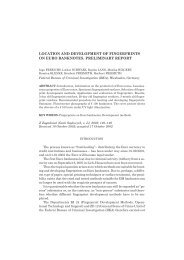Pobierz PDF - PROBLEMS OF FORENSIC SCIENCES
Pobierz PDF - PROBLEMS OF FORENSIC SCIENCES
Pobierz PDF - PROBLEMS OF FORENSIC SCIENCES
Create successful ePaper yourself
Turn your PDF publications into a flip-book with our unique Google optimized e-Paper software.
428<br />
it is thus evident that not all systems for interpreting<br />
projective material are reliable. after completing<br />
a review and assessment of projective techniques,<br />
a group of critically-inclined researchers, lilienfeld,<br />
Garb, wood and Nezworsky, produced a number of<br />
recommendations [19, 32; see 56] for their use. the<br />
first is that only systems of interpretation that have<br />
been empirically verified and whose research accuracy<br />
has been confirmed should be employed. it<br />
should be noted here that we are differentiating not<br />
between particular diagnostic techniques but, more<br />
subtly, between various systems of interpretation. this<br />
is because where the Rorschach technique or human<br />
figure drawing are concerned there are several systems<br />
at least that come into consideration, some of<br />
which are empirically grounded and some not. why<br />
is it, though, despite the doubts and the criticism, that<br />
projection techniques, and especially those wrongly<br />
called so, are used so often? there would appear to<br />
be two sources of origin for this state of affairs. on<br />
the one hand a lack of knowledge reduces the psychometric<br />
interpretation of the “objective” results of<br />
tests to the level of assessing the attribute in question<br />
in the categories “high”, “average” and “low”, which<br />
is hard to acknowledge as satisfactory for someone<br />
whose purpose is to diagnose people rather than simply<br />
to describe test results. a lack of humility, on the<br />
other hand, leads psychologists to think that there is no<br />
need to refer to external, “objective” criteria and that<br />
knowledge of life, intuition, a “nose for diagnosis”<br />
and other personal attributes will suffice [45]. Yet the<br />
research should caution us against regarding these attributes<br />
(diagnostic experience especially) as guarantees<br />
of a good diagnosis. cases in which experienced<br />
practitioners have arrived at diagnoses less accurate<br />
than those of laymen or psychology students are not<br />
infrequent. this is because their long-term experience<br />
has amounted to conserving errors, because they have<br />
not taken steps to improve their skills and because<br />
they have not reflected critically on their own practise<br />
[10, 17]. the authors provide a broader account of this<br />
issue elsewhere [59; see also 44, 58].<br />
a certain regularity emerges when reviewing projective<br />
techniques and those mistakenly called projective.<br />
techniques that truly are projective are associated<br />
with systems of interpretation that are supported<br />
to some degree in the research (though it may sometimes<br />
be hotly disputed), as in the case of the cS exner<br />
system for the Rorschach technique. meanwhile, the<br />
accuracy of those techniques erroneously described as<br />
projective is not proven by any empirical arguments<br />
– either because very few or no studies of them have<br />
been made or because they have been published in<br />
Problems of Forensic Sciences 2013, vol. 93, 421–437<br />
K. Stemplewska-Żakowicz, W. J. Paluchowski<br />
handbooks only. the situation regarding the original<br />
handbooks, whose contemporary reissues lack critical<br />
analysis, as well as meta-analysis, of the empirical<br />
data they cite, is also telling. these works are treated<br />
as messages from the past that should be patiently deciphered<br />
in the form one finds them in and not given<br />
another thought. Despite this, discussions of these<br />
techniques that draw on data generated in numerous<br />
studies have appeared from time to time and they have<br />
concluded that techniques such as the lüscher test, the<br />
Szondi test and graphology are unreliable.<br />
could it be that the keenness of these discredited<br />
techniques to be defined as projective is a means of<br />
concealment? is it to somehow justify the fact that<br />
they do not meet the requirements for reliable diagnostic<br />
tools? if these are the strategies they will be of little<br />
avail. the categorisation of techniques as objective or<br />
projective techniques [37] is of dwindling significance<br />
in contemporary diagnosis. the key questions are<br />
whether a technique has a theoretical basis, whether<br />
its accuracy is supported by empirical evidence and<br />
whether it has other desirable properties. this concerns<br />
not just projective techniques, but all diagnostic<br />
techniques.<br />
references<br />
1. anastasi a., urbina S., testy psychologiczne, pracownia<br />
testów psychologicznych ptp, warszawa 1999.<br />
2. Bellak l., the thematic apperception test, the children’s<br />
apperception test, and the Senior apperception<br />
technique in clinical use, Grune and Stratton, New York<br />
1986.<br />
3. Bellak l., the concept of projections an experimental investigation<br />
and study of the concept, Psychiatry 1944, 7,<br />
353–370.<br />
4. Bellak l., on the problems of the concept of projection,<br />
[in:] projective psychology. clinical approaches to the<br />
total personality, abt l. e., Bellak l. [eds.], alfred a.<br />
knopf, New York 1950.<br />
5. Borstelman l. J., klopfer w. G., Does the Szondi test<br />
reflect individuality?, Journal of Personality 1951,19,<br />
421–440.<br />
6. Borstelman l. J., klopfer w. G., the Szondi test a review<br />
and critical evaluation, Psychological Bulletin<br />
1953, 50, 112–132.<br />
7. corman l., le test du dessin de famille, presses universitaires<br />
de France, paris 1964.<br />
8. crawford e., Gross J., patterson t. [et al.], Does children’s<br />
colour use reflect the emotional content of their<br />
drawings?, Infant and Child Development 2012, 21, 198–<br />
215.
















